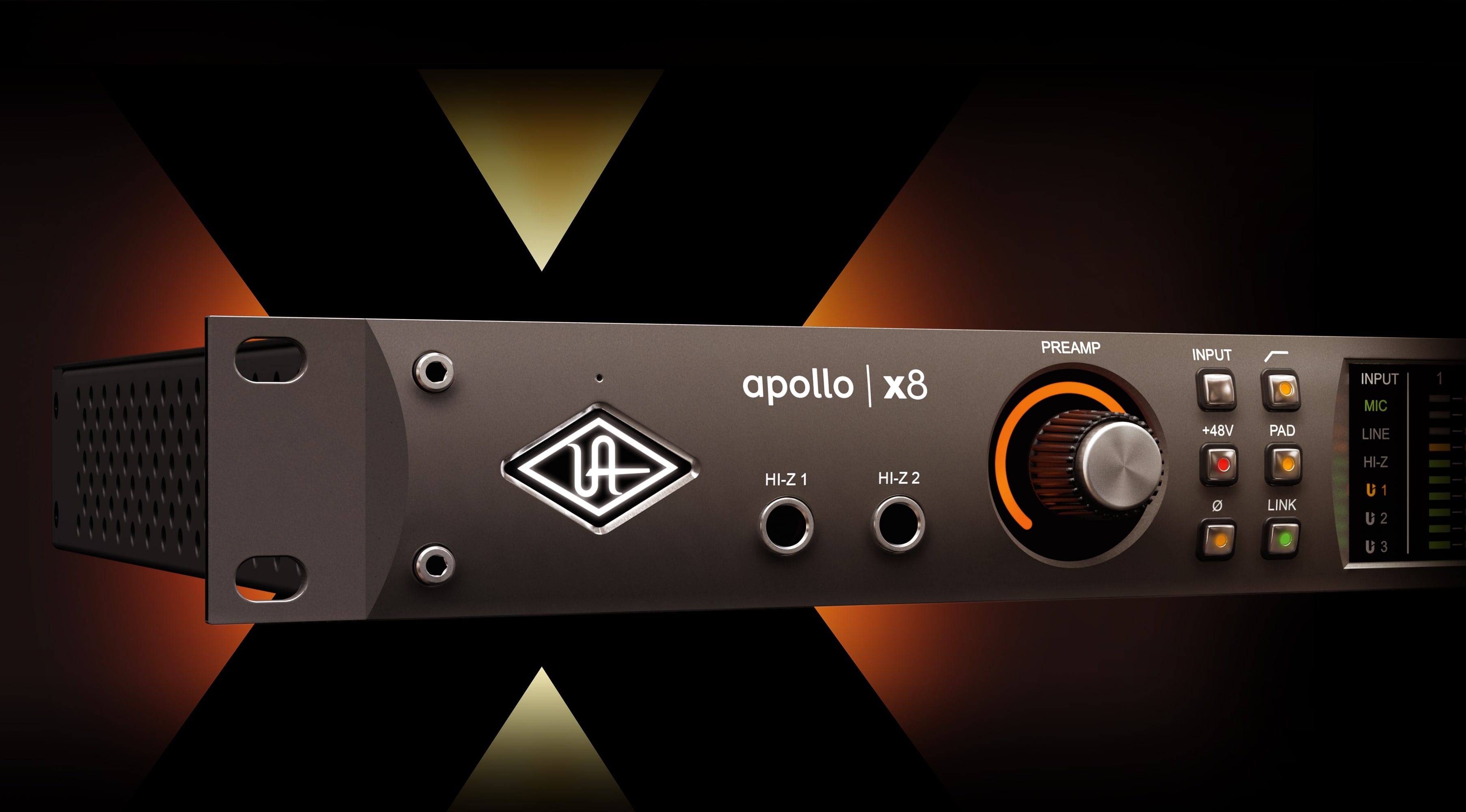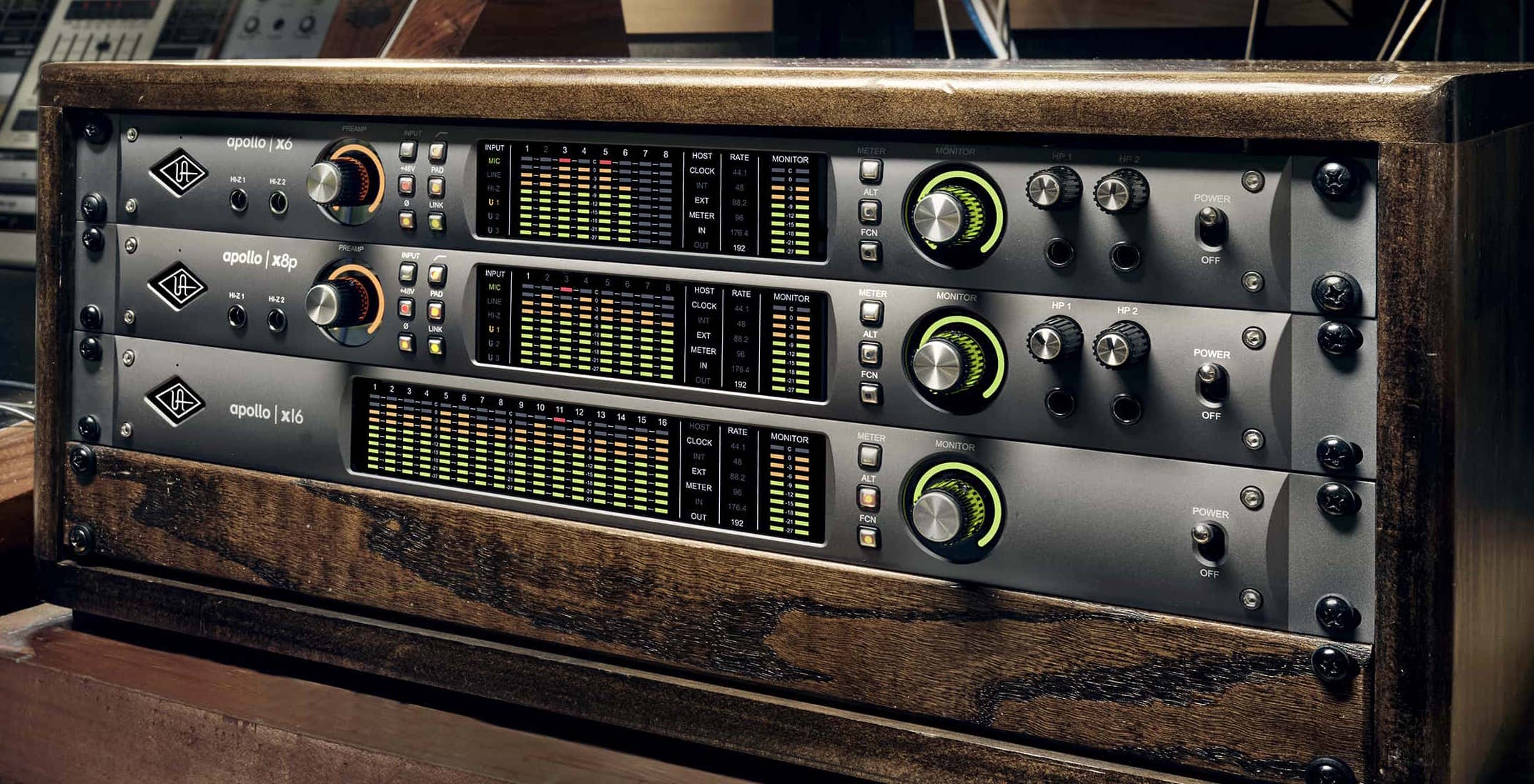New Gear Review: Apollo x8 and x Series Interfaces from Universal Audio

Universal Audio’s Apollo x series boasts flexible I/O, onboard DSP, and monitoring capabilities—could one function as the centerpiece for your studio?
The Apollo x8 is a part of Universal Audio’s newest line of Thunderbolt 3 audio interfaces.
The Apollo x series is designed for tracking, overdubbing, and mixing. All the entries in this line feature high-quality A/D and D/A conversion, dual-crystal clocking, surround sound monitoring capabilities, and a new “HEXA Core” processor for 50% more UAD plugin processing than the prior generation.
Sitting in the middle of thew new Apollo x line, the x8 interface has a lot of features to offer medium-sized home recording studios, and even small commercial studios. Today we’ll take an in-depth look at this model in particular to see what it—and the whole new line—is all about.
For those in need of more or less I/O within the Apollo x series, there’s the Apollo x16 and x6 respectively, and for those who need additional preamps, an x8p model is also available. Although the exact feature set varies, the entire line is built from essentially the same DNA. Let’s have a closer look.
Features
The Apollo x8 allows you to record at sample rates up to 192 kHz, in 24 bit. There are 18 x 24 simultaneous input/output channels, which include 8 channels of analog-to-digital conversion through the interface’s mic, line, and Hi-Z inputs.
Also included are 14 channels of digital-to-analog conversion via 8 mono line outputs, stereo monitor outputs, and 2 stereo headphone outputs. There are 10 channels of digital I/O via 8 ADAT optical I/O with S/MUX for high sample rates, 2 channels of coaxial S/PDIF I/O with sample rate conversion, and two Thunderbolt 3 ports that allow you to daisy-chain together other Thunderbolt devices.
Fortunately, these Thunderbolt 3 ports are also backward compatible with Thunderbolt 1 & 2 ports on your Mac. You’re actually able to combine up to 4 Apollos and 6 total UAD-2 devices using a Thunderbolt 3 connection, which allows you to increase I/O and DSP as your studio expands. As it’s probably clear, there are plenty of hardware connectivity options available to you, making recording a small band or integrating external hardware like compressors, EQs, and spatial effects no problem.
This audio interface includes 4 digitally-controlled analog mic preamps with Unison technology for integration with UAD preamp, amp, and pedal plugins. The unit’s front panel allows you to control the preamp parameters, along with the included Console software (more on that later). These parameters include switchable low cut filters, 48V phantom power, pad, polarity inversion, and stereo linking.
The buttons to the right of the main display on the Apollo x8 include METER, ALT, and FCN. The METER button allows you to select between monitoring the input or output level of different tracks, the ALT button will enable you to toggle between a pair of main monitors and a secondary set of monitors, while the FCN button provides an assortment of functions based on what you assign it to do in the Control software.
I like to use the FCN button in Mono mode for quick access to a mono switch, but you can also set it to None, Alt 2 (for a third pair of monitors), Dim (to attenuate output level), or Talkback which allows you communicate with the talent in your live room.
The Preamp knob allows you to control preamp gain. Pressing the Preamp knob switches between outputs, and pressing the Monitor knob will enable you to mute and unmute your output signal. There’s a gain control knob for each headphone output, and a power switch on the front of the unit as well.
On top of all these hardware features, the Apollo x8 also includes Universal Audio’s aforementioned Console software. Console is where you’re able to apply UAD plugins to your input channels for realtime plugin processing and control track parameters like pan, solo, mute, and fader levels. You’re able to remotely control the Unison preamps from here, internally re-route audio, create custom headphone mixes, and much more.
The 4 Unison-enabled mic/line preamps allow you to record through authentic Neve, API, Manley, and SSL preamp emulations; this processing, along with the processing provided by all other UAD plugins, can be baked into your signal at the recording level. This means you can commit to an emulation of a UA 610-B, Teletronix LA-2A, and a Pultec EQP-1A, for example, to a vocal during recording. Let’s not forget that the analog equivalent of this processing chain would cost thousands of dollars to purchase, and that all of these plugins and more are included with the Apollo x8.
One of the most significant selling points of the Apollo x8 is that it allows you to run UAD plugins, which include many excellent emulations of classic analog equipment. These plugins can be run in realtime, which means you can apply them to your audio signal while recording, without introducing latency.
If you want to run a headphone mix to your performer so that they can hear the affects of the processing applied to their voice/instrument, realtime processing will allow for that; this can prompt performances in which your talent interacts with auditory feedback like delays and reverbs. In my opinion, Universal Audio is one of the best analog-modeling companies out there. If you search up plugin vs. hardware comparisons on YouTube, Universal Audio emulations tend to sound almost indistinguishable from the original analog units.
The Realtime Analog Classics Plus Bundle is the plugin package included with the Apollo x8. It consists of the UA 610-B, Marshall Plexi Classic Amplifier, Fairchild 670 Legacy, Teletronix LA-2A Legacy, UA 1176LN Legacy, UA 1176SE Legacy, Pultec EQP-1A Legacy, Pultec Pro Legacy, Ampeg® SVT-VR Classic Bass Amp, Precision Channel Strip, Precision Reflection Engine, Precision Delay Modulation, Precision Delay Modulation L, UA Precision Enhancer Hz, Raw Distortion, and RealVerb-Pro. Overall, this is an excellent handful of UAD plugins to get you started or to add to your existing collection.
A major selling point for many fans of the brand is that the Apollo x8 provides onboard DSP. This means that if your project session is filled with UAD plugins, it will free up your computer’s CPU for other tasks. Even though the Apollo x8 provides quite a substantial amount of DSP, you’re likely going to max it out if you’re mixing a massive project session solely with UAD plugins. Having said this, working in combination with all the other plugins I regularly use, I haven’t maxed out the DSP of my Apollo x8 yet.
In Use
Overall, I’m incredibly impressed with this interface. It’s entirely revolutionized my workflow, and has made recording audio and routing audio to my external hardware a breeze. It has eliminated my need for a separate monitoring station and has become the centerpiece of my studio.
I rely quite heavily on UAD plugins for mixing and mastering purposes now; it really is quite incredible how powerful these devices are. I went all-out and got the UAD-2 Ultimate bundle that includes 99 UAD-developed plugins. You save a lot of money on each plugin by bundling them in this way, and so far, I haven’t been disappointed.
It’s quite easy to navigate and control the Console software. Many other companies that have tried to integrate software like this with their interfaces just haven’t pulled it off that well. I keep Console open on a separate computer monitor while mixing, and it’s almost just like having an analog control console right at my fingertips. The software is extensive enough that it covers all the bases needed, but remains simple enough that it’s quick to learn how to use.
To Be Critical
My biggest complaint with the Apollo x8 is that when you sum your stereo signal into mono using the ALT button, there’s an output level increase. This makes A/B testing my mixes in stereo and mono quite irritating. I’m not sure if this is something that can be changed with a software update, but a level-matched Mono switch would be an excellent addition to this audio interface.
In general, the build quality of the Apollo x8 feels sturdy. I’m not sure what Universal Audio was thinking when they decided to implement wobbly Preamp and Monitor knobs since they seem to be the only flimsy part of the unit’s construction. This isn’t a deal breaker for me, but it somewhat detracts from the interface’s tactile appeal.
Summing it Up
The Apollo x8 deserves a tremendous amount of praise. Priced at $2,499, it’s a great value when you take into consideration the hardware specs and processing power it provides, along with the included UAD plugins and Console software.
If you’re serious about recording and want a top-notch audio interface with a healthy number of ins and outs, as well as onboard DSP, the Apollo x8 is a solid contender. I should also mention that the Apollo x8 has replaced my old audio interface, and is something that I now use on a regular daily basis.
Charles Hoffman is a mixing and mastering engineer at Black Ghost Audio. After graduating from the University of Manitoba with an English degree, Charles completed his audio education at Icon Collective in Los Angeles, CA.
Please note: When you buy products through links on this page, we may earn an affiliate commission.









